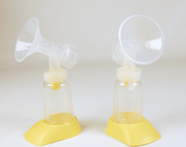10 Steps for Effective Pumping

Pumping can be a challenge under the best of circumstances. It feels a little strange because of the newness, it’s certainly not as effective as a baby and it can sometimes be frustrating to figure out.
Try these tried-and-true tips to help you effectively pump:
1. Use a decent pump. You may not need a full-size pump if you only pump occasionally as a stay-at-home-mom, but it is still worthwhile to learn the differences between pumps. The range is broad, from hospital-grade double electric to manual pumps. Don’t discount hand expression; many mothers get quite good at this and like it better than using a pump. Talk to a registered lactation consultant to identify which pump may be best for your situation. Avoid a previously owned pump; in addition to being against FDA regulations due to contamination, pump motors often wear out gradually. You may still feel suction, but the motor may be impaired by age or even storage conditions in extreme temperatures (such as an attic).
2. Pump when you are comfortable. Don’t make the first time that you pump a “gotta.” Pump after a feeding to see what it feels like and to learn about your pump. You won’t get much – but that doesn’t matter. Be sure that you are comfortable, sitting up straight with your back supported by a pillow or cushion if needed. When you are at work or school, pump where you will be undisturbed. If you can listen to music, this may increase your sense of privacy.
3. Adjust your suction. High suction doesn’t necessarily mean more milk; it usually means pain! If the suction setting is too strong, it can actually collapse the ducts and prevent milk flow, leading you to believe that you are losing your supply. Instead, adjust your suction setting to a comfortable place and leave it there.
4. Adjust your speed. Depending on the type of pump you are using, you may also have a speed adjustment. This setting can really help with effective pumping. Start off at the highest speed; a hungry baby sucks vigorously. When your milk starts to flow with let-down (which you may or may not feel), slow the speed down to the mid range. If you want to trigger another let-down, increase the speed again when milk flow slows to a trickle.
5. Think of your baby. To trigger the milk ejection reflex (or let-down), think of your baby. Pump while she is sleeping or playing so you can watch her. If you are at work or school, bring a picture to look at. In addition, breast massage before and during pumping can help you relax and allow the ducts to empty. Inhaling his scent from an item of clothing or a blanket serves as a form of aromatherapy and helps with let-down.
6. Think ahead. If you are preparing to return to work or school, start early – at least two weeks before your return. This will help you create a stockpile of milk and prepare your body for the adjustment of exclusive pumping during the day. The same rule applies if you will be separated from your baby, such as a trip or hospitalization.
7. Take care of tenderness. If your nipples feel sore while pumping, first check the suction settings (see tip #3). If the settings are ok, you can apply a little olive or vegetable oil at the bend of the pump flange where the nipple is centered to reduce friction. Avoid lanolin at this site because it can actually create a drag on the skin due to the stickiness of the ointment, increasing your soreness. If this still doesn’t help, talk to a lactation consultant to evaluate whether or not you have the correct size of flanges.
8. Use your childbirth breathing techniques. All of those breathing techniques that you learned in childbirth class can help you pump as well. Slow, deep breaths help with relaxation, contributing to milk let-down.
9. Remember that longer isn’t better. If you are pumping to increase your milk supply, remember that longer pumping times usually only lead to soreness. It is actually better to double pump for 15 minutes more frequently; this stimulates higher levels of hormone release.
10. Multitask! Pumping can get really boring. Once you get used to pumping, you can do other things at the same time. This can provide a distraction from pumping and can also help with milk ejection reflex. Try working on the computer, talking on the phone, writing, watching TV or eating – something moms don’t always have time for!
Denise Altman, R.N., IBCLC, LCCE, is a private-practice lactation consultant and nurse educator in Columbia, South Carolina. The name of her business, All The Best, reflects the skills, service and products she strives to offer expectant and new families. She is also the mother to twin girls and a son. Visit Denise on the web at www.feedyourbaby.com.





